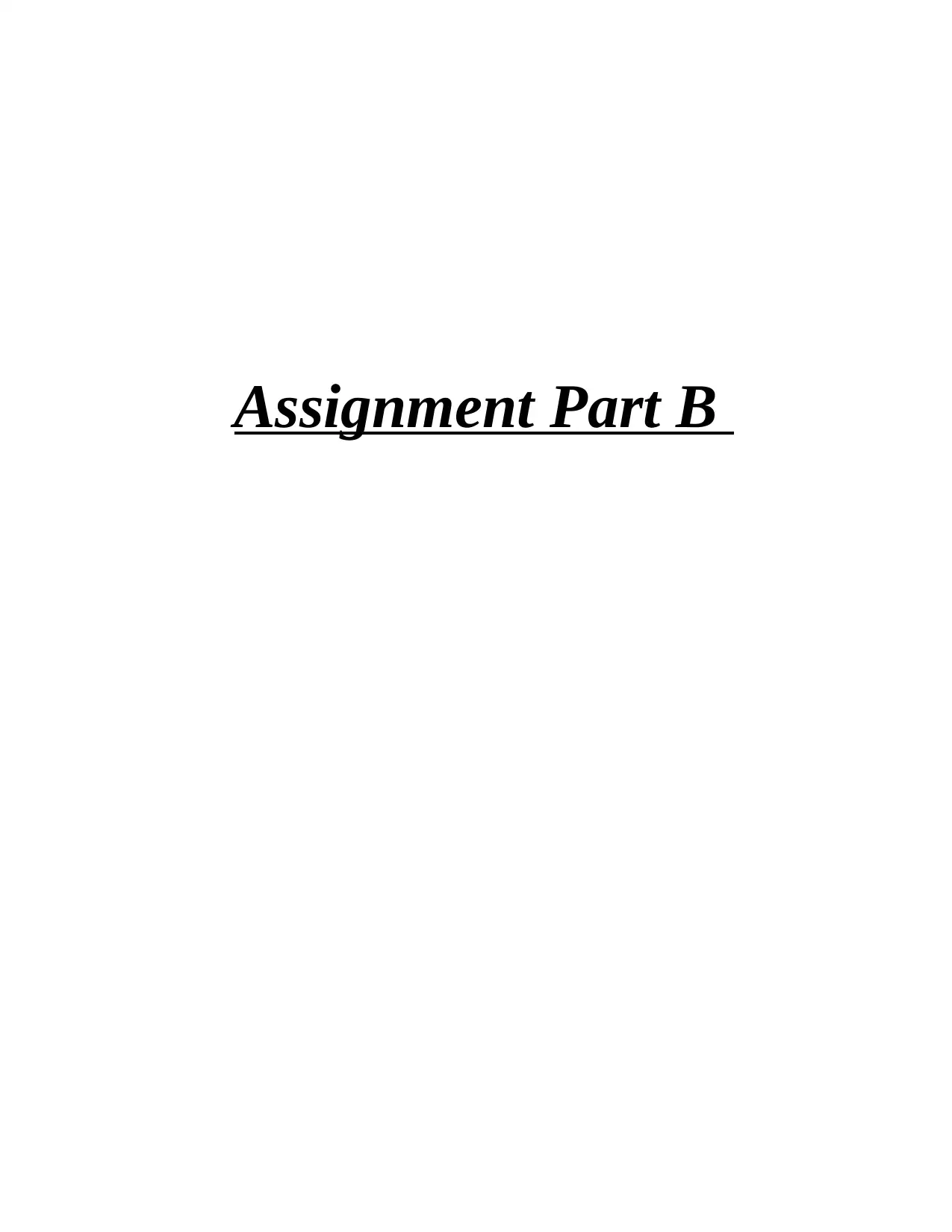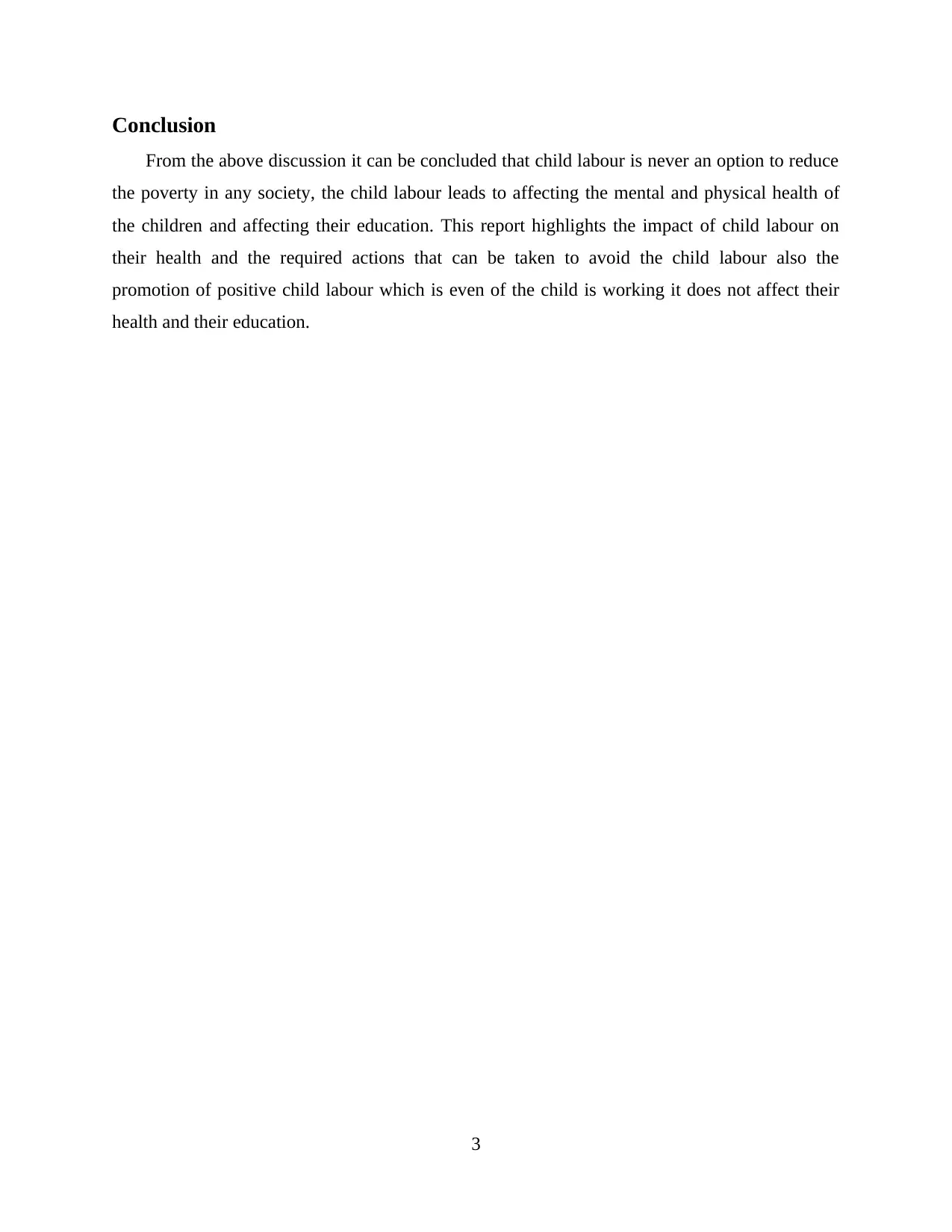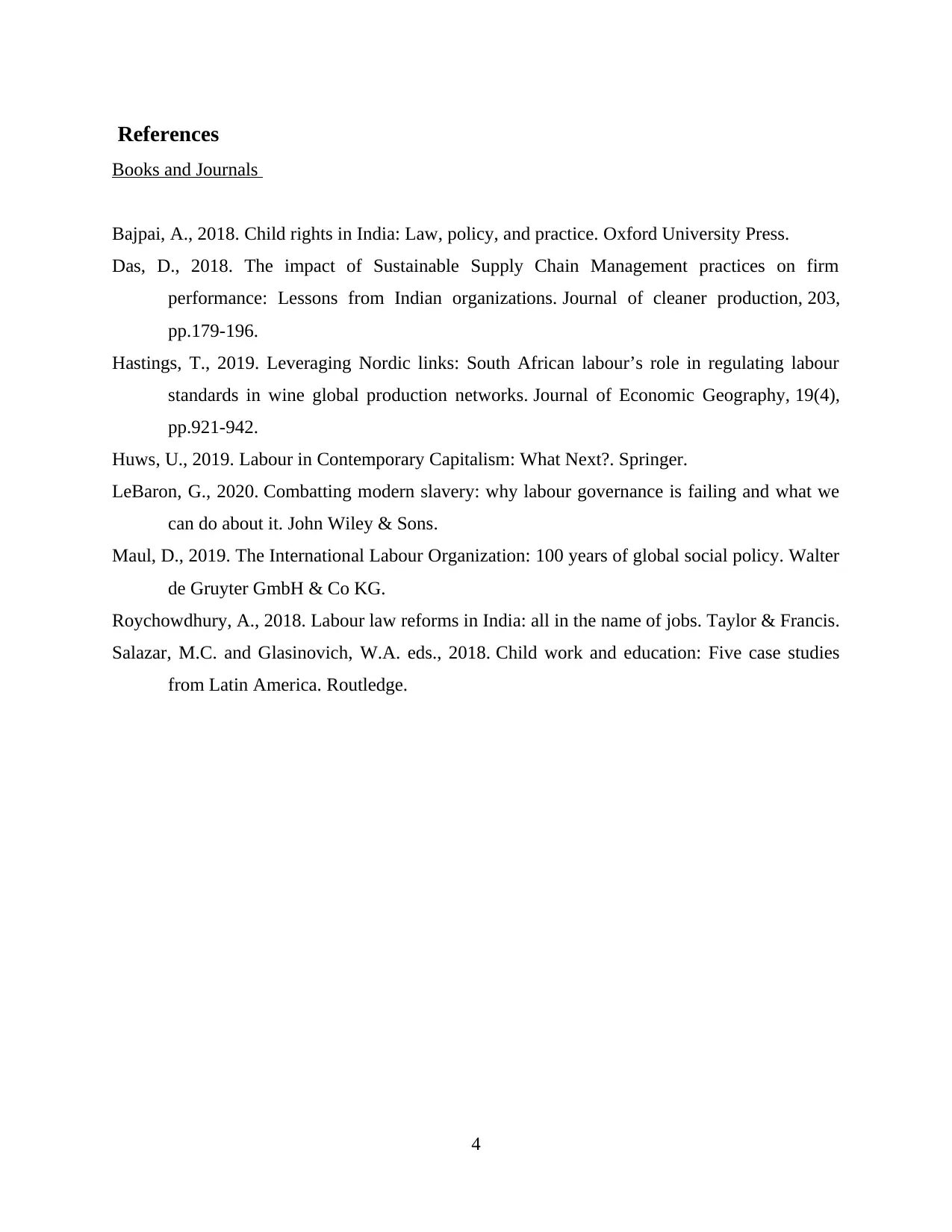Child Labour Report: Impact on Health, Education, and Economy
VerifiedAdded on 2022/12/05
|6
|1316
|215
Report
AI Summary
This report provides a comprehensive analysis of child labour, focusing specifically on its prevalence within global supply chains. It highlights the detrimental impacts of child labour on children's health, education, and overall development, emphasizing the long-term consequences for both individuals and society. The report explores the various stages of the supply chain where child labour is most prevalent and examines the root causes, including poverty and lack of access to education and healthcare. It differentiates between negative and positive child labour, where the latter does not affect health or education. The report also discusses the need for urgent actions, including stricter regulations, awareness campaigns, and collective efforts from businesses and governments to eliminate child labour. Furthermore, it underscores the role of international bodies in protecting children and promoting ethical labour practices, advocating for policies that prioritize children's well-being and economic growth. The report concludes with a call to action, emphasizing that child labour is not a solution to poverty and highlighting the importance of sustainable solutions for the future.

Assignment Part B
Paraphrase This Document
Need a fresh take? Get an instant paraphrase of this document with our AI Paraphraser

Table of Contents
Introduction......................................................................................................................................1
Main Body.......................................................................................................................................1
Conclusion.......................................................................................................................................3
References........................................................................................................................................4
Introduction......................................................................................................................................1
Main Body.......................................................................................................................................1
Conclusion.......................................................................................................................................3
References........................................................................................................................................4

Introduction
Child labour is an increasing concern for the society, the term child labour is defined as
where because of the work the children are deprives of their childhood, their potential and their
dignity and working in their early hood which leads to affecting their physical and mental health
development. The children working which doesn’t affect their health and personal development
or affect their schooling should be termed as the child labour which is termed as positive. This
report highlights the child labour in the supply chain, the increasing number of child labour in
the supply chain and it impact on their health, education and physical and mental health.
Main Body
In an business, a product has to go through various stages in order to reach to the final stage,
it an report it is analysed that in an international supply chain mentioned that they employee
child labour in almost every stage of supply chain, there are more than 150 million child labours
around the globally, out of which more than 28% are deployed in the international supply chains,
child labour occurs in many areas of the business particularly in the rural and the areas where the
labour market governance or the trade unions are in the weaker positions. In case of supply
chain, the child labour may be seen as working in the workshops or homes or involved in the
production of international goods and services (Bajpai, 2018).
The international labour organisation stated that all children who work are engaged in
child labour, but i think that as long as the work is not affecting their mental, physical health and
does not any effect on their education then it can be term as the positive. There can be seen many
negative impact of the child labour which affects their mental and physical development.
Some of the major negative impact of the child labour on the children’s can be:
Education: One of the major impact of the child labour is seen is on the education of the
children’s, if the children’s are working for long hours they won’t to able to attend school which
will affect their growth and development (Das, 2018).
Physical and mental health: working in the early age can directly impact the physical
and mental health of the children’s, as they have to work in unhealthy working condition without
any proper medical facilities available, it is seen that child labour are more likely to be seen as
getting the more health and mental health problems, it is increasing concern for the society as the
number of child labour are increasing in the supply chain (Hastings, 2019)
1
Child labour is an increasing concern for the society, the term child labour is defined as
where because of the work the children are deprives of their childhood, their potential and their
dignity and working in their early hood which leads to affecting their physical and mental health
development. The children working which doesn’t affect their health and personal development
or affect their schooling should be termed as the child labour which is termed as positive. This
report highlights the child labour in the supply chain, the increasing number of child labour in
the supply chain and it impact on their health, education and physical and mental health.
Main Body
In an business, a product has to go through various stages in order to reach to the final stage,
it an report it is analysed that in an international supply chain mentioned that they employee
child labour in almost every stage of supply chain, there are more than 150 million child labours
around the globally, out of which more than 28% are deployed in the international supply chains,
child labour occurs in many areas of the business particularly in the rural and the areas where the
labour market governance or the trade unions are in the weaker positions. In case of supply
chain, the child labour may be seen as working in the workshops or homes or involved in the
production of international goods and services (Bajpai, 2018).
The international labour organisation stated that all children who work are engaged in
child labour, but i think that as long as the work is not affecting their mental, physical health and
does not any effect on their education then it can be term as the positive. There can be seen many
negative impact of the child labour which affects their mental and physical development.
Some of the major negative impact of the child labour on the children’s can be:
Education: One of the major impact of the child labour is seen is on the education of the
children’s, if the children’s are working for long hours they won’t to able to attend school which
will affect their growth and development (Das, 2018).
Physical and mental health: working in the early age can directly impact the physical
and mental health of the children’s, as they have to work in unhealthy working condition without
any proper medical facilities available, it is seen that child labour are more likely to be seen as
getting the more health and mental health problems, it is increasing concern for the society as the
number of child labour are increasing in the supply chain (Hastings, 2019)
1
⊘ This is a preview!⊘
Do you want full access?
Subscribe today to unlock all pages.

Trusted by 1+ million students worldwide

Urgent actions needed
There should be strict actions needed to be taken, child labour should be avoided by each
and every organisation it should be the fundamental right at the work of freedom from the child
labour, everyone should target to remove this from every organisation, collective actions must be
taken, business needs to ensure there are effective practices and rules are followed in the
organisation to avoid the child labour.
There should be effective awareness regarding the child labour in the society and in the
organisations, each organisation should respect the minimum age for employees to work in order
to avoid the child labour and corrective actions needed to be taken in order to secure the their
organisation from child labour. The child labour is a growing concern for the society, they are
easily employed by the supply chain as they have to be paid less by the organisation as compared
to the other mature employees which is beneficial for the organisation, also organisation doesn’t
have to spend more on providing other benefits to them as a child they are not aware of such
thing which save lots of cost of the company, that is the reason there are more number of child
labours in the supply chain (Huws, 2019).
This can affect the economy of the country as children’s are doing work rather than studying
and developing themselves, government needs to take strict action regarding this case. The child
labour can be challenging to see, it is because of many reasons such as they have to work
because of the poverty which is caused by lack of decent work for adults, lack of access to the
health care, free quality education. The family issues or personal issues force many children to
work. In such circumstances the main responsibility of eliminating the child labour lies in the
hand of government bodies including labour inspectors, management and workers. Each
organisation linked to the supply chain needs to ensure that there is not child labour involved.
The international bodies like international organisation of employees and international trade
union confederation are actively working towards protecting and eliminating any kind of child
labour in the organisation (LeBaron, 2020). The society needs to understand that child labour can
not remove the family from the poverty, the child labour will only affect the physical, mental
health of the child. Government needs to ensure that proper rules are set in case of child labour;
children working without affecting their physical and mental health and also without effecting
their education needs to be considered as the positive child labour. The child labour in the supply
chain needs to be controlled for the better future and the growth of the economy (Maul, 2019).
2
There should be strict actions needed to be taken, child labour should be avoided by each
and every organisation it should be the fundamental right at the work of freedom from the child
labour, everyone should target to remove this from every organisation, collective actions must be
taken, business needs to ensure there are effective practices and rules are followed in the
organisation to avoid the child labour.
There should be effective awareness regarding the child labour in the society and in the
organisations, each organisation should respect the minimum age for employees to work in order
to avoid the child labour and corrective actions needed to be taken in order to secure the their
organisation from child labour. The child labour is a growing concern for the society, they are
easily employed by the supply chain as they have to be paid less by the organisation as compared
to the other mature employees which is beneficial for the organisation, also organisation doesn’t
have to spend more on providing other benefits to them as a child they are not aware of such
thing which save lots of cost of the company, that is the reason there are more number of child
labours in the supply chain (Huws, 2019).
This can affect the economy of the country as children’s are doing work rather than studying
and developing themselves, government needs to take strict action regarding this case. The child
labour can be challenging to see, it is because of many reasons such as they have to work
because of the poverty which is caused by lack of decent work for adults, lack of access to the
health care, free quality education. The family issues or personal issues force many children to
work. In such circumstances the main responsibility of eliminating the child labour lies in the
hand of government bodies including labour inspectors, management and workers. Each
organisation linked to the supply chain needs to ensure that there is not child labour involved.
The international bodies like international organisation of employees and international trade
union confederation are actively working towards protecting and eliminating any kind of child
labour in the organisation (LeBaron, 2020). The society needs to understand that child labour can
not remove the family from the poverty, the child labour will only affect the physical, mental
health of the child. Government needs to ensure that proper rules are set in case of child labour;
children working without affecting their physical and mental health and also without effecting
their education needs to be considered as the positive child labour. The child labour in the supply
chain needs to be controlled for the better future and the growth of the economy (Maul, 2019).
2
Paraphrase This Document
Need a fresh take? Get an instant paraphrase of this document with our AI Paraphraser

Conclusion
From the above discussion it can be concluded that child labour is never an option to reduce
the poverty in any society, the child labour leads to affecting the mental and physical health of
the children and affecting their education. This report highlights the impact of child labour on
their health and the required actions that can be taken to avoid the child labour also the
promotion of positive child labour which is even of the child is working it does not affect their
health and their education.
3
From the above discussion it can be concluded that child labour is never an option to reduce
the poverty in any society, the child labour leads to affecting the mental and physical health of
the children and affecting their education. This report highlights the impact of child labour on
their health and the required actions that can be taken to avoid the child labour also the
promotion of positive child labour which is even of the child is working it does not affect their
health and their education.
3

References
Books and Journals
Bajpai, A., 2018. Child rights in India: Law, policy, and practice. Oxford University Press.
Das, D., 2018. The impact of Sustainable Supply Chain Management practices on firm
performance: Lessons from Indian organizations. Journal of cleaner production, 203,
pp.179-196.
Hastings, T., 2019. Leveraging Nordic links: South African labour’s role in regulating labour
standards in wine global production networks. Journal of Economic Geography, 19(4),
pp.921-942.
Huws, U., 2019. Labour in Contemporary Capitalism: What Next?. Springer.
LeBaron, G., 2020. Combatting modern slavery: why labour governance is failing and what we
can do about it. John Wiley & Sons.
Maul, D., 2019. The International Labour Organization: 100 years of global social policy. Walter
de Gruyter GmbH & Co KG.
Roychowdhury, A., 2018. Labour law reforms in India: all in the name of jobs. Taylor & Francis.
Salazar, M.C. and Glasinovich, W.A. eds., 2018. Child work and education: Five case studies
from Latin America. Routledge.
4
Books and Journals
Bajpai, A., 2018. Child rights in India: Law, policy, and practice. Oxford University Press.
Das, D., 2018. The impact of Sustainable Supply Chain Management practices on firm
performance: Lessons from Indian organizations. Journal of cleaner production, 203,
pp.179-196.
Hastings, T., 2019. Leveraging Nordic links: South African labour’s role in regulating labour
standards in wine global production networks. Journal of Economic Geography, 19(4),
pp.921-942.
Huws, U., 2019. Labour in Contemporary Capitalism: What Next?. Springer.
LeBaron, G., 2020. Combatting modern slavery: why labour governance is failing and what we
can do about it. John Wiley & Sons.
Maul, D., 2019. The International Labour Organization: 100 years of global social policy. Walter
de Gruyter GmbH & Co KG.
Roychowdhury, A., 2018. Labour law reforms in India: all in the name of jobs. Taylor & Francis.
Salazar, M.C. and Glasinovich, W.A. eds., 2018. Child work and education: Five case studies
from Latin America. Routledge.
4
⊘ This is a preview!⊘
Do you want full access?
Subscribe today to unlock all pages.

Trusted by 1+ million students worldwide
1 out of 6
Related Documents
Your All-in-One AI-Powered Toolkit for Academic Success.
+13062052269
info@desklib.com
Available 24*7 on WhatsApp / Email
![[object Object]](/_next/static/media/star-bottom.7253800d.svg)
Unlock your academic potential
Copyright © 2020–2025 A2Z Services. All Rights Reserved. Developed and managed by ZUCOL.





